
|   |

|   |
Dhauli Kalinga Mahotsav - Tapati Chowdhurie e-mail: tapatichow@yahoo.co.in Photos courtesy: Orissa Dance Academy March 20, 2024 Every dust particle at the foothills of Dhauli breathes history - poignant, spiritual, transformational. It is this spot that had the seeds of Dharma Vijaya in place of Digvijaya, it is at this auspicious spot on the banks of the Daya that the Dhauli Kalinga Mahotsav is being held for the last two decades. The Mahotsav makes a statement every year that glorifies the country's soft power. This three day long festival held from the 9th to the 11th of February 2024, held a torch to vocalist Rupak Kumar Parida's musical talent, to Orissa Dance Academy's retelling of 3000 year long history of Odisha through Odissi and the folk forms of the land, Gurusaday Dutt's revival of Raibense dance from the verge of extinction, Kathak dance of North India, Meera Das and group's performance of 'River' in legendary Kelucharan Mohapatra genre of Odissi, Mayurbhanj Chhau, Bharatanatyam and lastly to Janardan Raj Urs' linking of tales of the great epics to contemporary martial art. This grand festival held at Shanti Vihar on the foothills of Dhauli, Bhubaneswar, was organised jointly by The Department of Odia Language, Literature and Culture, Government of Odisha and Orissa Dance Academy in association with Odisha Sangeet Natak Akademi and Art Vision. The main objective of this festival is to preserve, promote and popularize this unique heritage at the national and international level. The festival is a confluence of more than 200 artistes belonging to various art forms of Indian dance tradition, celebrating unity in diversity. Music recital by Rupak Kumar Parida of Bhubaneswar inaugurated the festival. He sang popular and melodious songs like "Chap tilak sab chini", "Mohe apne hi rang mein", "Maula tera noor", "Duma dum mast kalandar" and "Rashke qamar" with drummer Bikashit Sahoo, tabalia Nikunja Bihari Samal, dholakia Dwitikrisha Panda, guitarist D. Shuresh Patro, keyboard player Chandrakanta Tripathy and flautist Samya Ranjan Joshi accompanying him. With his mellifluous voice, Rupak has created a niche for himself. To put it in a nutshell Lord Jagannath who is the symbol of all philosophies and thoughts says everything that has to be told about the Odia people and their land. He is a symbol and a statement of who the Odia people are. Unstoppable like the chariot of Lord Jagannath, Odia civilization too rolls across centuries, continuous and ever growing. Ancient temples of Odisha gave life to the poetry of the soul. Words followed and evolved into poetry carved on stone. Poets like Sudramuni Sarala Das took the Odia language to the very peak of linguistic achievement very early in the history of Odia as a language. Even as the world today grapples with racism and gender discrimination, Odia poets like Balaram Das, had offered the idea of an egalitarian, casteless society, five hundred years ago, centuries ahead of his time. Poet Jagannath Das invented a brilliant poetic style, revolutionising the Bhagwat from the elite Sanskrit original, making it accessible to every Oriya household. This tradition of reading and oral transmission under the practice of Bhagawata Tungi formed a foundational principle that binds the people of Odisha even today. Upendra Bhanja was yet another poet who enriched the Odia language through his skill in words, style, and aesthetics and placed Odia at par with Sanskrit. A poet sensitive to human pain and suffering, he connected Odia sensibility with ideals of equality and compassion. Disasters such as the super cyclone at the end of the last millennium seemed to break the backbone of Odisha, which did not deter the Odia people from following the path of progress. 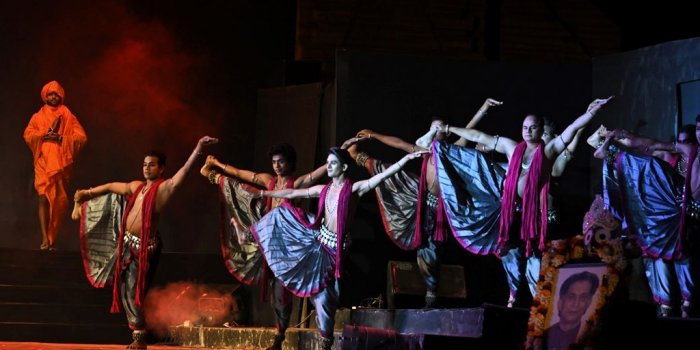 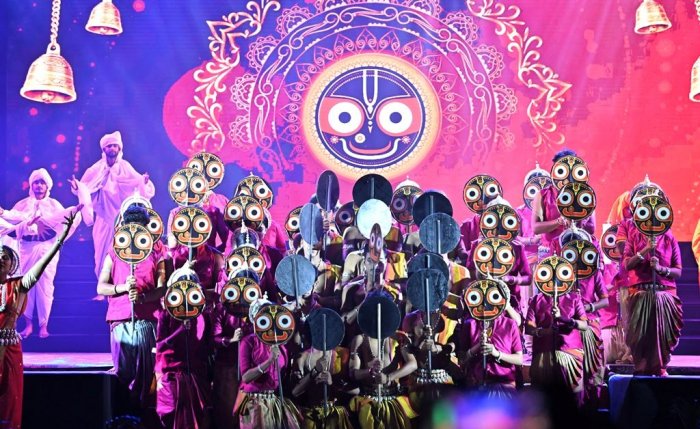 Aruna Mohanty's group To translate the three thousand years of history of the sons and daughters of the soil and the land now we know as Odisha in the language of dance, truly speaking, in the hands of a master choreographer has broken the glass ceiling. To incorporate the diverse elements of the culture of the land was an insurmountable task, which Aruna Mohanty has succeeded in achieving. Jaati Nandighosh - the music of joy - saw quick scenario changes with a number of performers making their entry and exit in a jiffy. The lyrics were taken from traditional Odia literature text; additional lyrics were penned by the script writer and poet Kedar Mishra. The rich traditional music by Guru Ramhari Das resonated long after hearing it. Violinist Agnimitra Behera, rhythm composer Guru Dhaneswar Swain and Ajaya Kumar Choudhury created wondrous effects. The talented co-choreographer Janardhan Raj Urs provided the visuals. Voice over was by M. Ravi while the light designer Debiprasad Mishra was in his element. Concept and choreography was by Guru Aruna Mohanty assisted by Guru Niranjan Rout. It was an amazing event in which as many as a team of 160 dancers from Orissa Dance Academy, Utkal Sangeet Mahavidyalaya, Nupur, Nrutya Naivedya, Odissi Dance Creations, Mokshya, Cornucopia Creations, Nrutya Darshan Academy, Nrutyatma, Shibakshya and Swakiya Foundation danced in a spirit of joy. There was much exuberance which spilled over to the audience. Accompanists Dhaneswar Swain and Buddhanath Swain, vocalist Nazia Alam, Rupak Kumar Parida, Matruprasad Das, Milan Kumar Panda and Sritama Nanda, tabalia Ajaya Kumar Chaudhury, percussionist Baibhab Kumar Dash and Buddhanath Swain, flautist Srinibas Satapathy, sitarist Rabi Shankar Pradhan, violinist Agnimitra Behera, Probir Sarkar, Lalit Kishore Bhattacharya and Ashis Biswas and others of the huge ensemble were the excellent music providers who were together responsible for the success of the mega production. Costume-in-charge Sridutta Bhol and Madhusmita Mohanty were at their best. Nandi Ghosha was the cultural representation of Odisha's journey through millenniums as they reminisced 3000 years of history, heritage, tradition, of art, craft, language, literature and lifestyle. The presentation mesmerized the audience. 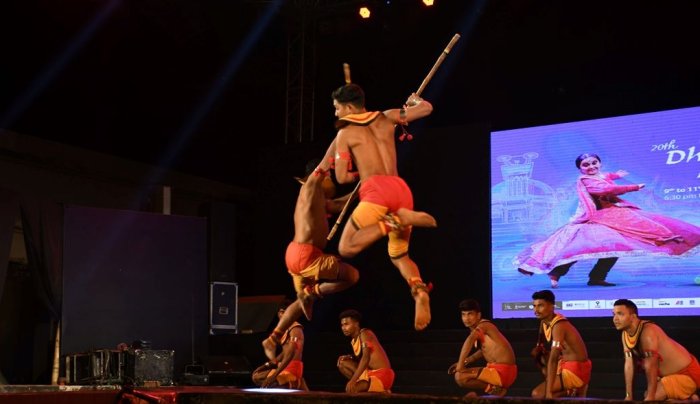 Raibanshe dance The first evening's last presentation was Raibanshe Dance by Sarabhuja Dance Theatre, Midnapore led by Guru Tarun Pradhan. Raibenshe, a folk martial dance form evolved from ancient martial arts practiced by the soldiers for physical as well as mental training. The dance was accompanied with wild yells of the men and punctuated with gestures that suggested drawing of bows from the quiver, throwing of spears, brandishing of knives and flourishing of swords and scimitar. The pieces were choreographed and directed by Guru Tarun Pradhan. Performed by male dancers, this genre of dance was revived by Gurusaday Dutt, a freedom fighter and an ICS officer to boot. Raibenshe was so named, because of the acrobatics performed with long bamboo sticks. The performers wore brass anklets (nupur) on their right ankle. This dance was accompanied by dhols (drums) and kanshis (cymbals).  Ishira Parikh and Maulik Shah's group The second day's programme commenced with Antar Naad - A bridge to Divinity - which was a reflective cultural spectrum presented as an ecstatic encounter where the audience was taken into a journey of emotional catharsis, an embodiment of a human being's strong connect with the supreme power. Disciples of Kathak maestro Kumudini Lakhia, the talented couple Ishira Parikh and Maulik Shah performed with their students of Anart. Known for their attention to minute details they presented 'Nirvighnam' which laid bare the aura and energy of Lord Ganesha. Peace, harmony and prosperity descends on mankind by the mere chanting of his name. The twelve names of Ganesha depicted the blessings the Lord bestows on us. Excellence was the keyword of the piece. Performers led by Maulik Shah and Ishira Parikh were Kadam Parikh, Raina Parikh, Naisargi Gor, Priyanka Pandit, Yesha Bhatt who captivated the audience. Music was composed by Nishant Jignesh. The next piece 'Raghav Raghuraai' was about the much revered Lord Ram, an incarnation of Lord Vishnu who is worshipped and adored by one and all. The hero of the great epic Ramayana finds his place of pride in Indian literature across all regions. "Raghav Raghuraai" is a verse on him, who is an epitome of valour, forbearance and virtuous sovereignty. On the historic occasion of Shri Ram's homecoming to Ayodhya it was their offering. The piece was performed as duet by Maulik Shah and Ishira Parikh to the music composition of Pandit Niraj Parikh. Mystical melodies flowing from the magical bansuri, which adorns Krishna's lips - charming, enthralling and intoxicating was the next piece. In the piece 'Bansuriya,' Krishna the enchanter and the eternal lover, the omnipresent one, who charms Radha and the gopis with his very presence playing his magical flute recreating Vrindavan in the beautiful venue was truly enthralling. Captivating visuals emerged at various levels, when dancers wove their way through the images created by the magical web. Krishna and his bansuri and his various manifestations, Radha and the gopis stole the hearts of the audience. The grand finale 'Utsav' or celebration drew a fitting line to their recital. It was a kind of thanksgiving for the gift of life, the joy of living, a sense of freedom which brought the performers and the rasikas on the threshold of happiness.  Meera Das group Meera Das' presentation of 'From a drop to ocean' traced the source that makes living possible on earth. Whether it is a gentle and clear brook or a murmuring and gurgling stream or a fall cascading down majestically or a river - calm or turbulent - meandering its way through unknown lands to finally merge with the ocean was a soothing watch. The powerful and unique movements of Odissi dance beautifully expressed the theme using imageries as comparisons, visuals or no visuals.  Mayurbhanj Chhau Abhisek Tripathy and group from Khurda performed Mayurbhanj Chhau under the guidance of Ileana Citaristi. Mayurbhanj Chhau of Odisha is performed without wearing masks. The mainstay of the form is the martial art movements usually performed by male dancers. At Dhauli Kalinga Mahotsav, Chhau performers used their genre to portray a contemporary problem that mankind in general is faced with, rather than the themes usually danced on. Plastic bags and the danger faced by mankind, because it's not bio-degradable was the theme of the production. 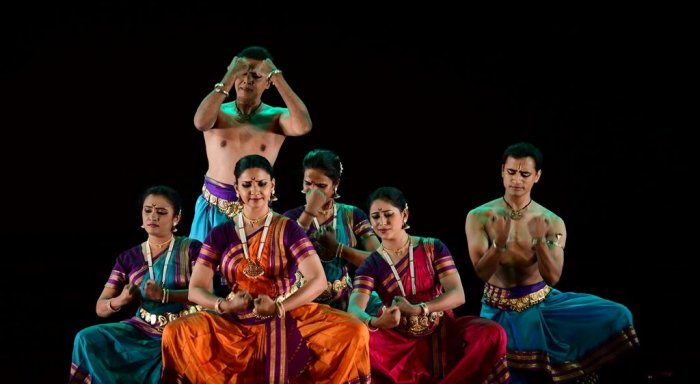 Vaibhav Arekar & group Bharatanatyam exponent Vaibhav Arekar evoked the teachings of the Bhakti saints of the 16th and 17th century of Maharashtra that is of much relevance today as it was then. The most loved god heading the Hindu pantheon Sri Krishna and his wife Rukmini, is Sri Vithala and Rakhumai in Pandharpur, Maharashtra. To the evolved souls of saint poets of Maharashtra like Sant Tukaram, Vithoba was present in his beautiful form as well as beyond his form as the Omnipresent one. Vaibhav Arekar who is known for his creative thinking presented this beautiful 'bhakti bhava' frame of mind with a Misra Alarippu accompanied by a Vishnu namavali of the lord on music, immediately bonding with the rasikas. The abstraction of the piece was used to represent the omnipresent aspect of the lord of Pandharpur. He followed it up with an abhanga of Tukaram maharaj. The rupa varnana of the Lord standing on a brick with his hands resting on his waist was like liquid poetry painted by a clever craftsman. The description of the lord wearing his golden pitambara and makara kundala, the dark hued lord pacifying the restless hearts of his bhaktas, who seek shelter in him was etched remarkably. The next abhanga propounded the importance and strength of 'naama sankirtana'. The 'Pavitra Naama' of Sri Rama is sufficient for householders stuck in this word of illusion of duality, was stressed in an easily comprehensible way. As Rama Naama is the path that will keep us detached from illusion and in close proximity with the only and the ultimate truth was the message of the piece. The abhanga described three episodes from Ramayana praising lord Rama as he restored Dharma on earth. The episodes of "Tratika vadha", where Rama protects the yagya of Rishi Kaushik and restores order in his ashram; the rescue of Ahalya with his blessings and Sita Swayamvar where he crushes the ego of mighty Ravana and many other kings as he lifts the bow was aesthetically presented using "Dhanya te sansaari" of Sant Namdev. It was a beautiful piece presented aesthetically with much nobility of expression befitting the character of Rama. The next abhanga of Sant Ekanath established the thought of "Ekeshwaravaada", celebrating the duality of forms through lord Shiva and lord Vishnu. Plurality of the form is an exquisite feature of Hindu religion propounding singular thought via multiplicity. And there's no other thought that can be more relevant in today's time when division has become the politics of life. This abhanga was the metaphorical representation of the unity that is the need of the hour. The message said that though the eyes see two forms, the mind should realise that the entity is just one. When the mind is enticed with this rupa and gunas, his name is the only vachana where it finds solace. The composition celebrated the importance of Naama Sankirtana which is the core of Varkari Sampradaya of Pandharpur. As these Varkaris journey along the banks of river Chandrabhaga, the sky resonates with the name of Vitthala. All bhaktas proceed towards Sri Vitthala leaving their egos of caste and creed behind. They touch each other's feet as a symbol of crushing their egos of mundane identity to realise the Supreme reality. The troupe concluded with Vitthala Naama Sankirtana. Bhava and rasa, the two fundamental elements of dance, poured forth in full measure at every moment creating a delectable flavour savoured by rasikas. "Khel mandiyela" by Sant Tukaram was the concluding piece. A whole collection of the abhangas gave us a glimpse of the Bhakti movement of Maharashtra in medieval times which has passed the test of time. 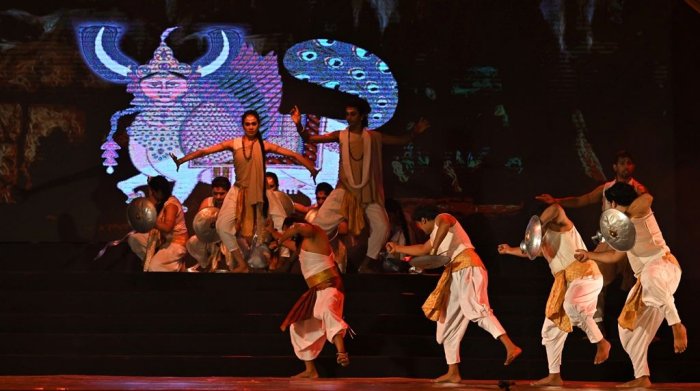 Janardhan Raj Urs group Highly promising performer cum teacher Janardhan Raj Urs trained under Guru Maya Rao is a choreographer par excellence with a master's degree in history. He is the Director of Cornucopia Creations. Glimpses of his training in martial arts like Thang Ta of Manipur, Kalaripayattu of Kerala and Ninjutsu from Japan besides his training in Sanskrit dance-drama presentation, was discernible in his presentation of 'Maha Kshatriya' at the Mahotsav. Being fascinated by the story of Vishwamitra and Vasishta, he chose from the works of Devudu Narasimha Sastri's 'Maha Brahmana' to choreograph the piece. The story line of Maha Kshatriya was about Koushika who was a mighty and proud monarch. Soon realization dawned on him that worldly wealth and physical might were nothing compared to spiritual valour. This turned him into severe austerities, which transformed him to a sage named Viswamitra. According to mythology, Viswamitra's penances in the Himalayas made him strong and invincible. As Rishi Viswamitra, he was bestowed with the sacred Gayatri Mantra. The choreographer visualized a new life in these changing times and reflected in his choreography that "one should be guided by dharmacharyas like Viswamitra to uplift their life and transmit these ideas to the world." Whether people take his message to heart or not, Janardhan's dance choreography was flawless. Years of learning the art of dance and using the stage to advantage was commendable. The mythology was powerfully portrayed. Onlookers stayed glued to their seats with bated-breath to see the unfolding of the powerful drama. Lead artiste Janardhan Raj Urs himself along with Chethan, Monish D, Thejas Kumar, Anand Menon, Rakshith, Upasana Gurjer, Kavya B, Sakshi Taula, Ahana Das, Arathi and Shreshta Murugan created marvel on stage. Janardhan was supported on the production by Aruna Mohanty. Music composer Praveen D Rao enhanced the beauty of the piece. As lighting designer Janardhan was helped by Debashish Mishra. The programme was anchored with proficiency by Srinibas Ghatuari and Nazia Alam.  Tapati Chowdhurie trained under Guru Gopinath in Madras and was briefly with International Centre for Kathakali in New Delhi. Presently, she is a freelance writer on the performing arts. |